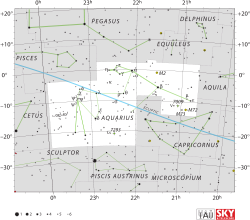Top Qs
Timeline
Chat
Perspective
Upsilon Aquarii
Star in the constellation Aquarius From Wikipedia, the free encyclopedia
Remove ads
Upsilon Aquarii is a binary star[10] system in the equatorial constellation of Aquarius. Its name is a Bayer designation that is Latinized from υ Aquarii, and abbreviated Upsilon Aqr or υ Aqr. This star is faintly visible to the naked eye with an apparent visual magnitude of 5.21.[2] Parallax measurements give a distance estimate of 75.1 light-years (23.0 parsecs) from Earth.[1] This is a high proper-motion star[11] that is drifting closer to the Sun with a radial velocity of –2.3 km/s.[4] It is part of the Hercules-Lyra association of co-moving stars.[10]
The primary component is an F-type main sequence star with a stellar classification of F7 V.[3] Age estimates range from 250[7] million to 1.7[6] billion years old, and it is spinning with a projected rotational velocity of 35 km/s.[8] The star has 1.32 times the mass of the Sun and 1.45 times the Sun's radius. It is radiating 3.6 times the Sun's luminosity from its photosphere at an effective temperature of 6,606 K,[6] giving it the yellow-white hue of an F-type star.[12]
The star displays an excess of near infrared radiation, suggesting it has a circumstellar disk of dusty debris.[13] This disk has a mean temperature of 75±17 K and is orbiting at an estimated radius of 84±41 AU.[14] A faint stellar companion was detected in 2007 at the Gemini Observatory, with a separation of 6.09″±0.03″ from the primary.[10] This is equivalent to a physical projected separation of 139 AU, which yields an estimated orbital period of ~1,330 years.[15] The debris disk is orbiting close to the dynamically unstable region of this system.[14]
As of 2024, the NASA Exoplanet Exploration Program has deemed this star one of the "most accessible to survey for potentially habitable exoplanets with the Habitable Worlds Observatory".[6]
Remove ads
References
External links
Wikiwand - on
Seamless Wikipedia browsing. On steroids.
Remove ads

